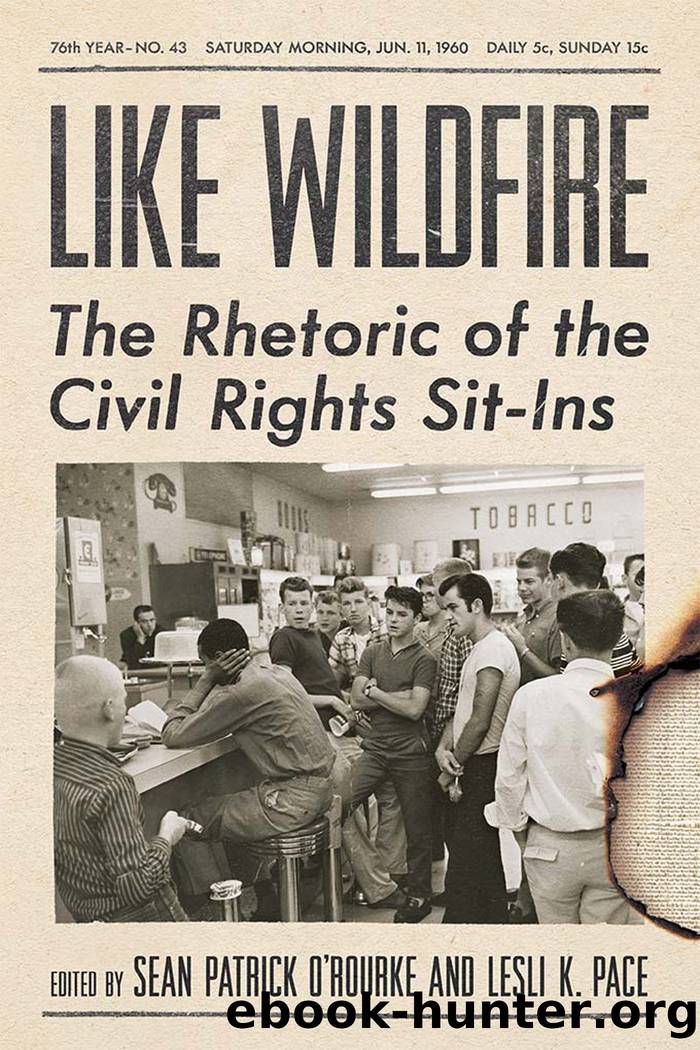Like Wildfire by Sean Patrick O'Rourke

Author:Sean Patrick O'Rourke
Language: eng
Format: epub
Publisher: University of South Carolina Press
Published: 2020-07-15T00:00:00+00:00
Protestors Become Mythic
According to Rowland, “There seems to be general agreement that myths are crucial stories that are in some way treated as true by the people who tell them.”35 One of the key components is that “a myth is a story about heroic characters who serve as personal or societal models.”36 The presence of heroines and heroes is of little doubt, but who they are is interesting. Martha Solomon notes, “Certainly, most of us would acknowledge that texts do constrain meanings, but I for one believe that each person’s ‘meaning’ for a text is a product of a complex interaction between that person’s perceptual frames, etc. and elements in the text.”37 Depending on the viewers’ attitude toward segregation, the archetypes of hero and villain are cast accordingly. Heroes and heroines are engaged in a struggle with an enemy and obstacles that must be overcome. The photograph visualizes a step in the hero’s journey.
Joseph Campbell’s notion of the monomyth also clarifies the photograph, illuminating characteristics that contribute to the impact of the activists sitting at the counter.38 Some of the key characteristics of classic heroines and heroes are presented in the photograph, most notably polutas, arête, and metis. Polutas is the quality of an enduring heart capable of continuing during times of suffering. The three protestors sitting at the lunch counter seem to have this quality as they patiently and calmly endure the crowd’s harassment. Just as Odysseus was made to suffer by Poseidon, so too do the nonviolent protestors absorb taunts, physical assault, and intimidation. They also possess arête, or excellence. Their purpose of protesting for equality and justice aligns with a sense of virtue and reveals the pursuit of the highest standards of civility and citizenship. Metis, or a blending of cleverness, cunning, and wisdom, is demonstrated in the act they are performing. By turning the traditional lunch counter into a place of dissent, they make clear the planning and strategic nature of their actions.
Blackwell’s photograph also provides a model for future social movement activity. The photograph depicts protestors in a very specific way. The non-violent nature of their protest activity is civil yet powerful. It is not just the nature of their protest but also the fact that they are doing it in unison that is telling. It would be too easy to read it as “us versus them,” a simple black and white rendering, but that misses the chance for the text to unify the viewer not only with the protestors but also with the mob and other people around the country viewing the same image. The protestors are all from Tougaloo, the nearby historically black college, and therefore have an investment in the community, but they come from different locations in the country. The constitutive function here is not one that parcels off particular groups from a larger population or community but rather one of unity through plurality. A black Mississippian, a white southerner, and a Scotch Native American acted in solidarity despite differences in gender, age, race, and ethnic backgrounds.
Download
This site does not store any files on its server. We only index and link to content provided by other sites. Please contact the content providers to delete copyright contents if any and email us, we'll remove relevant links or contents immediately.
| General | Discrimination & Racism |
Nudge - Improving Decisions about Health, Wealth, and Happiness by Thaler Sunstein(6633)
iGen by Jean M. Twenge(4702)
The Fire Next Time by James Baldwin(4342)
Adulting by Kelly Williams Brown(3668)
The Sports Rules Book by Human Kinetics(3587)
The Hacking of the American Mind by Robert H. Lustig(3579)
The Ethical Slut by Janet W. Hardy(3502)
Captivate by Vanessa Van Edwards(3296)
Mummy Knew by Lisa James(3166)
In a Sunburned Country by Bill Bryson(2945)
Ants Among Elephants by Sujatha Gidla(2924)
The Worm at the Core by Sheldon Solomon(2917)
Suicide: A Study in Sociology by Emile Durkheim(2609)
The Slow Fix: Solve Problems, Work Smarter, and Live Better In a World Addicted to Speed by Carl Honore(2574)
Humans of New York by Brandon Stanton(2379)
Handbook of Forensic Sociology and Psychology by Stephen J. Morewitz & Mark L. Goldstein(2376)
Blackwell Companion to Sociology, The by Judith R. Blau(2318)
The Happy Hooker by Xaviera Hollander(2274)
Outliers by Malcolm Gladwell(2256)
